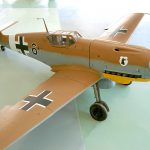A Messerschmitt BF109G-2 and a de Havilland Tiger Moth II, are the first of six new aircraft to arrive at the Royal Air Force Museum Cosford, having been transported by road from the museum’s sister site in London. Visitors can now view the brand new arrivals on display in the museum’s hangars with four more aircraft due to arrive before Christmas.
The Messerschmitt BF109G-2, designed by Willi Messerschmitt, is a legend alongside the British Spitfire, American P51 Mustang and the Japanese Zero. First flown in 1935, the Bf109 was obsolescent by the second half of World War Two yet it remained the backbone of the German Air Force’s day fighter force and was flown by many of her allies. In production right up to the end of hostilities, more than 33,000 were built second only to the Russian ‘Sturmovik’ as the most prolific military design, and post-war versions served with the Czech, Israeli and Spanish Air Forces, the latter until the mid-1960s – with Rolls Royce Merlin engines. Compact, rugged, fast and heavily armed the Bf109 has the distinction of being flown by the highest-scoring fighter aces in history. With the promised availability of the new Daimler-Benz DB 605A German built engine, design work began on the Bf109G series where higher speeds were obtained, but manoeuvrability and handling were adversely affected. The Bf109G series will be forever linked with the daylight bomber-killing missions in defence of the Reich. German fighter pilots found themselves facing heavily armed American B17 Fortress and B24 Liberator bombers and later long range P38 Lightning, P47 Thunderbolt and P51 Mustang fighters. Ground down by the overwhelming odds, few survived the war.
The museum’s rare example was disassemble by the museum’s team of Aircraft Technicians and Apprentices in London and transported on a low loader lorry along the M1, M6 and M54 before being reassembled in its new display hangar at Cosford. Members of the public can now view the aircraft in the museum’s ‘War in the Air’ hangar alongside fellow German fighter the Focke Wulf Fw190, facing their British equivalents the Supermarine Spitfire 1 and Hawker Hurricane IIc.
The second of the two new arrivals is the 1930s bi-plane the de Havilliand Tiger Moth II, originally produced as a development of the well-known Gipsy Moth. The Tiger Moth went on to become one of the world’s most famous training aircraft and provided the majority of RAF pilots with their elementary flying training during the Second World War. In the aftermath of the Dunkirk evacuation in 1940, almost any anti-invasion idea was considered and three extraordinary Tiger Moth conversions were put forward. Some were fitted with light bomb racks ready to undertake the bombing of enemy troops attempting a landing, whilst others were fitted with a tank in the front cockpit with powder dispensers located under the wings intended to dust the German troops with a poisonous insecticide as they waded ashore. A more revolutionary idea was the ‘paraslasher’; a scythe-like blade fitted to the aircraft and intended to cut parachutist’s canopies as they descended to earth. Fortunately none of these ideas had to be used, leaving Elementary Flying Training Schools to their vital role of pilot training.
The Tiger Moth was eventually succeeded and replaced by the de Havilland Chipmunk in the early 1950s and both aircraft can now be viewed alongside each other in Hangar 1 at Cosford, positioned next to the Scottish Aviation Bulldog T Mk 1, a further progression in training aircraft. The Tiger Moth also travelled by road to Cosford, alongside the Bf109 .
Other aircraft still to wing their way to Cosford before Christmas include the Wolverhampton built Boulton Paul Defiant M1, Junkers Ju 88R-1, Gloster Gladiator 1 and the Westland Lysander III. Work is already underway at the museum’s London site to prepare the aircraft for transportation by road to Cosford. Visitors will be able to see all of the new aircraft fully reassembled and in their new display positions by early 2017, with the exception of the Lysander which will spend a short period in the museum’s Conservation Centre before eventually going on display.
RAF Museum Cosford Curator, Al McLean said:“This will be the first time that we have been able to display a Bf 109 in the War in the Air hangar at Cosford and appropriately it will be seen confronting a Hurricane and a Spitfire.” The new aircraft arrivals will enable the RAF’s story to be more comprehensively represented to museum audiences in Shropshire, as the museum prepares to celebrate and commemorate the centenary of the Royal Air Force in 2018. Whilst there are major transformations planned for the museum’s London site, some exciting additions for Cosford will include exploring the first 100 years of the RAF, the role it plays today and its future contributions, as well as sharing the story online with a global audience.
Aviation fans can keep up to date with the centenary aircraft moves and on-going developments by signing up to the museums free e-Newsletter http://www.rafmuseum.org.uk/contact-us/newsletters.aspx .Entrance to the museum is free of charge and the museum is open daily from 10am until 4pm. For further information, please visit the museum’s website www.rafmuseum.org/cosford.































